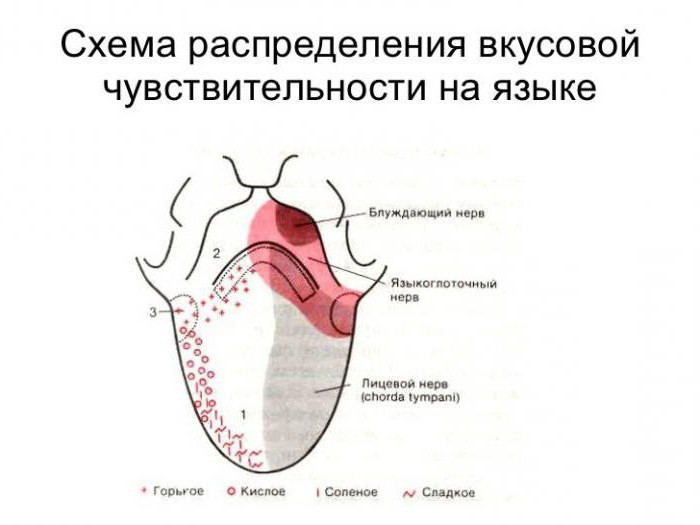Information from the outside world is perceived by our senses. Thanks to their selective work, the human body is able to adequately respond to all environmental changes. The end result of the functioning of the senses, namely hearing, vision, smell, taste, tactile sensitivity and the vestibular apparatus is the occurrence of sensations and recognition of stimuli.
The great Russian physiologist I.P. Pavlov established that the cortical centers of the brain participate in the formation of sensations, to which the centripetal nerves are stimulated by nerve ending receptors. Systems consisting of sections of the cerebral cortex and pathways - nerves and receptors, he called analyzers, or sensory systems. Taste analyzer, the structure and functions of which are determined by its anatomical and morphological features, will be studied in this article.
The mechanism of taste
Almost all the substances we use as food have a taste. In physiology, there are 4 main tastes: sweet, bitter, sour and salty, the perception and differentiation of which is carried out by the taste analyzer. The taste can be explained as the perception of the molecules of chemicals in food by receptors located in the oral cavity and on the tongue. To understand what function the taste analyzer performs, we turn to the study of its structure. So, let’s consider what this area of our body looks like.
Flavor Analyzer Departments
In our body there are special systems that are responsible for hearing, sight, smell, tactile feelings. The taste analyzer, the structure and functions of which we are studying, consists of three parts. The first is called peripheral, or receptor. It directly perceives environmental stimuli that cause weak currents in the nerve endings that transform into bioelectric impulses.
They are transmitted to the second section of the taste analyzer - conductive. It is represented by the afferent nerve. On it, the excitation enters the cortical part of the taste analyzer, which is a certain part of the brain in which the formation of taste sensations takes place.
Features of the peripheral department
The taste analyzer, as mentioned earlier, consists of three parts. Consider in more detail the receptor, or peripheral department. It is represented by chemoreceptors that perceive stimuli in the form of various chemical compounds, and recognizes them by strength, quality (modality) and intensity. Chemoreceptors are part of the taste buds, or bulbs, which are dotted with the oral cavity and tongue. The nerve endings that are sensitive to salty taste are located on the tip of the tongue and along its edges, to the bitter - on the root of the tongue, to the sweet - on the tip, to the sour - on the edges.

The taste bud itself does not go directly to the surface of the mucous membrane of the tongue, but has a connection with it through the taste season. Each chemoreceptor contains from 40 to 50 villi. The substances that make up the food contact and irritate them, as a result of which, in the peripheral part of the gustatory sensory system, a process of irritation arises, turning into excitement. With age, the threshold of taste sensitivity increases in people, that is, the ability to recognize diverse taste shades fades.
In animals, the sensitivity of the taste analyzer practically does not change with age, moreover, the connection between the taste and olfactory systems is much more pronounced. For example, in cats, taste buds (Jacobson tubes) are also olfactory nerve endings, which contributes to a more subtle distinction between food quality.
How does the conductor function?
Continuing to study the sections of the gustatory analyzer, we will examine how nerve impulses from the chemoreceptors can reach the brain. For this, there is a conductor part. It is represented by single-path fibers. It includes several nerves: facial, glossopharyngeal, vagus and lingual. It is through them that nerve impulses enter the stem part of the brain - into the medulla oblongata and the bridge, and from them - to the visual tubercles (thalamus) and, finally, to the temporal lobe of the cerebral cortex.
Damage to the conductor portion of the taste analyzer, for example, as a result of paresis of the facial nerve, leads to a partial loss of taste sensitivity. During surgical interventions, for example, during operations on the facial part of the skull, the conductivity of nerve impulses along the nerves of the single pathway, especially the vagus and facial, decreases, which also leads to a decrease in taste sensitivity.
Cortical department of taste sensory system
The cortical part of any of the existing analyzers is necessarily represented by the corresponding section of the central nervous system located in the cerebral cortex. It carries out the main functions of the taste analyzer - the perception and difference in taste sensations. Excitation along centripetal nerves enters the temporal lobe of the cerebral cortex, where the final differentiation of the salty, bitter, sweet and sour taste of food occurs.
The relationship of the structure and functions of the taste analyzer
All three departments of the taste sensory system are inextricably linked. Damage to any of these parts (receptor, conduction or cortical) or their connections with each other leads to a loss of ability to perceive and distinguish taste sensations. The anatomical structure of the taste analyzer determines the specificity of taste sensations that arise due to irritation of the chemoreceptors of taste buds.
Appetite. How does it arise?
The emotional and physiological need for food intake and those positive feelings that arise before its consumption and in the process of eating are usually called appetite. In addition to the organ of vision, taste and olfactory analyzers participate in its formation .
The smell, type of food and, of course, its taste are conditioned stimuli that cause a process of excitement in the nerve endings of the taste buds. It enters the digestive center located in the medulla oblongata, as well as in the structures of the limbic system and the thalamus.
Taste Recognition Mechanism
As was established by physiologists, in the chemoreceptors of the tongue, excitation arises as a result of food, olfactory and visual stimuli (taste, appearance and smell of food). The recognition of various types of taste (bitter, sweet, sour, salty) and their shades is carried out thanks to the analytical and synthetic activities of the higher part of the brain - the cerebral cortex. In its temporal lobe is the taste center.
The various pathologies and injuries to which the taste analyzer is subjected lead to ageusia - a partial or complete loss of taste sensations. It can also occur in a healthy person as a result of viral diseases of the upper respiratory tract (rhinitis, sinusitis), in which there is swelling of the nasopharyngeal mucosa. Hyperthermia (high temperature during inflammatory processes in the body) also reduces the sensitivity of chemoreceptors.
Sensory food analysis
Although the structure of the taste analyzer is the same for all people, for some of us, due to, above all, genetic characteristics, it has a low sensitivity threshold. As a result, there is an increased ability to distinguish more food shades and aromas. The taste analyzer, as well as olfactory in such people, called tasters, can differentiate in taste and smell, for example, from 200 to 450 types of tea. Most of us use the taste sensory system primarily to analyze the palatability of food products, thereby satisfying our need for fresh and high-quality food, which is necessary for the normal functioning of the gastrointestinal tract.

The taste sensitivity of chemoreceptors may vary. So, it rises during pregnancy (symptoms of toxicosis), while breastfeeding, in a state of stress. Under ordinary conditions, the taste can be enhanced, for example, by heating food to 30-40 ° C. This technique is used in the process of assessing the taste of dishes and drinks. For example, wine and beer are necessarily warmed up before tasting.
This article examined the structure and functions of the taste analyzer. His role in the perception and differentiation of environmental stimuli was also studied.